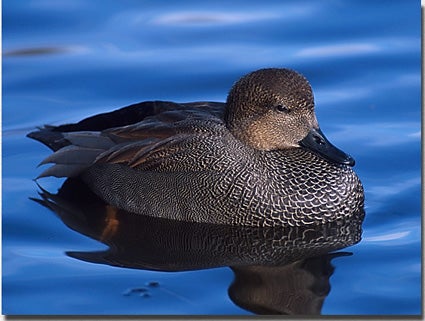SCIENTIFIC NAME:
Anas strepera
OTHER NAMES:
Gray duck.
STATUS:
Occasional breeder. Common in winter, fairly common to uncommon in spring and fall, and occasional in summer in all regions. Lowest Conservation Concern.
DESCRIPTION:
The gadwall is very easy to identify in hand; however, at a distance they are somewhat more difficult. Gadwalls are medium sized dabbling ducks that have what is termed non-distinct plumage. Male gadwall can be easily identified. The gray duck with a black rump, light brown head, white belly and a large white speculum are key identifying characteristics. In flight, male gadwalls exhibit a pronounced rusty red patch that is associated with the speculum. Females can be somewhat more difficult as they tend to resemble female mallards except the gadwall possesses a white belly and speculum. Hen mallards do not possess these traits.
DISTRIBUTION:
Gadwalls occur throughout the northern hemisphere generally between latitude 30 and 60 degrees. In North America, gadwalls are found primarily in the Mississippi flyway but do occur in all four flyways. These birds winter along the Gulf Coast and northern Mexico.
HABITAT:
Gadwalls are dabbling ducks. They prefer to feed in water depths that do not exceed 18 inches. Because of this, they prefer marshes, sloughs, ponds and flooded agricultural fields in which to feed. Gadwall can be found in both fresh and brackish water.
FEEDING HABITS:
The gadwalls main food source is aquatic vegetation, aquatic invertebrates and seeds. They primarily are surface feeders. Gadwalls will supplement their diet with insects, crustaceans, amphibians, mollusks and fish.
LIFE HISTORY AND ECOLOGY:
The gadwalls courtship display can be very elaborate. Males will grunt, whistle, and throw their head and tail up simultaneously in order to gain the attention of a female.
Gadwalls are monogamous in their breeding behavior. Adult pairs will bond in mid to late fall. Juveniles will usually pair up by mid-winter. The breeding season varies somewhat but usually occurs from May through mid-July.
Once breeding is complete, females will construct a nest of leaves, grass and down from her body. The average clutch size is from 7 to 13 eggs. Average incubation period is 26 days. The young that hatch are precocial. That is, once hatched they must obtain their own food.
Gadwalls may begin their southerly migration by leaving the breeding grounds in early to mid-September. They will over winter in areas as far south as northern Mexico and the Gulf Coast of Louisiana. Migration flights usually take place at night to avoid predation and conserve energy by flying in cooler temperatures.
REFERENCES:
Bellrose, F.C. 1976. Ducks, Geese and Swans of North America, 2nd. Ed. Stackpole Books.
Blevins, D. 2001. Gadwall (Anas strepera)
Cone, M., 2006. Anas strepera. http://animaldiversity.ummz.umich.edu/accounts/Anas_strepera/
AUTHOR:
Michael E. Sievering, Alabama Division of Wildlife and Freshwater Fisheries






